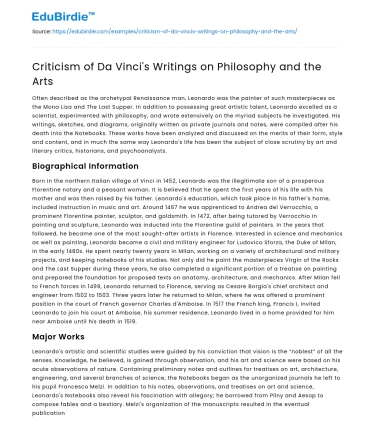Often described as the archetypal Renaissance man, Leonardo was the painter of such masterpieces as the Mona Lisa and The Last Supper. In addition to possessing great artistic talent, Leonardo excelled as a scientist, experimented with philosophy, and wrote extensively on the myriad subjects he investigated. His writings, sketches, and diagrams, originally written as private journals and notes, were compiled after his death into the Notebooks. These works have been analyzed and discussed on the merits of their form, style and content, and in much the same way Leonardo's life has been the subject of close scrutiny by art and literary critics, historians, and psychoanalysts.
Biographical Information
Born in the northern Italian village of Vinci in 1452, Leonardo was the illegitimate son of a prosperous Florentine notary and a peasant woman. It is believed that he spent the first years of his life with his mother and was then raised by his father. Leonardo's education, which took place in his father's home, included instruction in music and art. Around 1467 he was apprenticed to Andrea del Verrocchio, a prominent Florentine painter, sculptor, and goldsmith. In 1472, after being tutored by Verrocchio in painting and sculpture, Leonardo was inducted into the Florentine guild of painters. In the years that followed, he became one of the most sought-after artists in Florence. Interested in science and mechanics as well as painting, Leonardo became a civil and military engineer for Ludovico Sforza, the Duke of Milan, in the early 1480s. He spent nearly twenty years in Milan, working on a variety of architectural and military projects, and keeping notebooks of his studies. Not only did he paint the masterpieces Virgin of the Rocks and The Last Supper during these years, he also completed a significant portion of a treatise on painting and prepared the foundation for proposed texts on anatomy, architecture, and mechanics. After Milan fell to French forces in 1499, Leonardo returned to Florence, serving as Cesare Borgia's chief architect and engineer from 1502 to 1503. Three years later he returned to Milan, where he was offered a prominent position in the court of French governor Charles d'Amboise. In 1517 the French king, Francis I, invited Leonardo to join his court at Amboise, his summer residence. Leonardo lived in a home provided for him near Amboise until his death in 1519.
Save your time!
We can take care of your essay
- Proper editing and formatting
- Free revision, title page, and bibliography
- Flexible prices and money-back guarantee
Major Works
Leonardo's artistic and scientific studies were guided by his conviction that vision is the “noblest” of all the senses. Knowledge, he believed, is gained through observation, and his art and science were based on his acute observations of nature. Containing preliminary notes and outlines for treatises on art, architecture, engineering, and several branches of science, the Notebooks began as the unorganized journals he left to his pupil Francesco Melzi. In addition to his notes, observations, and treatises on art and science, Leonardo's Notebooks also reveal his fascination with allegory; he borrowed from Pliny and Aesop to compose fables and a bestiary. Melzi's organization of the manuscripts resulted in the eventual publication of Trattato della pittura (Treatise of Painting) in 1652. Melzi's heirs allowed the journals to be separated, sold, and discarded, a state of affairs that has presented a number of difficulties for scholars and researchers. In addition, Leonardo's unique orthographic style has also posed problems. He wrote in a mirror script, from right to left, and his handwriting remained essentially unchanged throughout his lifetime, making the establishment of a chronology of his works by means of handwriting analysis impossible.
Critical Reception
Despite the fact that Leonardo did not present his philosophical thoughts and views in an organized manner, but rather dispersed them throughout the Notebooks, critics have attempted to discern whether or not a guiding philosophy or a philosophical “system” can be found in Leonardo's work. Paul Valéry, attempting to explain why Leonardo is not often viewed as a philosopher, emphasizes that the quantity of notes and observations Leonardo left, as well as the disorganized manner in which he left them, call into question the nature of Leonardo's philosophical thinking. George Kimball Plochmann, however, maintains that Leonardo assuredly developed a philosophical system, one that is implicit throughout his writings. Its primary concerns are the concepts of existence and the nature of knowledge. This system, Plochmann concedes, is weakened by Leonardo's failure to make explicit the connection between his philosophical principles and the particular subject he was addressing at the moment. In his analysis of Leonardo's philosophy, Karl Jaspers also discusses Leonardo's views on knowledge and perception. Jaspers emphasizes that for Leonardo knowledge and one's understanding of nature is directly linked with vision and the supposed supremacy of vision over the other senses. D. van Maelsaeke, for his part, detects several similarities between Leonardo's natural philosophy and that of Johann Wolfgang von Goethe, including a shared belief in the experimental method and in nature as a force with both creative and destructive qualities.






 Stuck on your essay?
Stuck on your essay?

